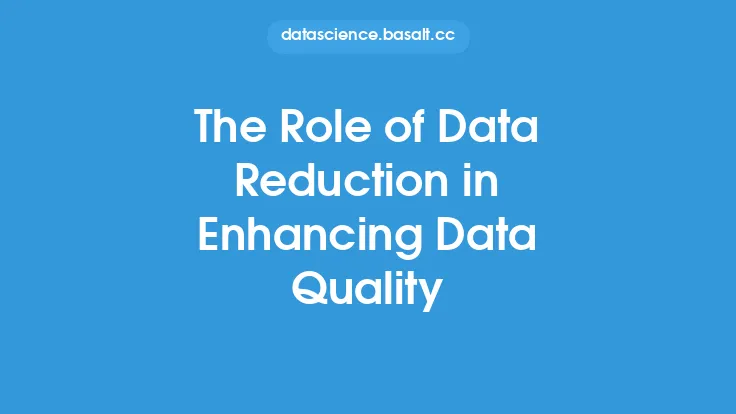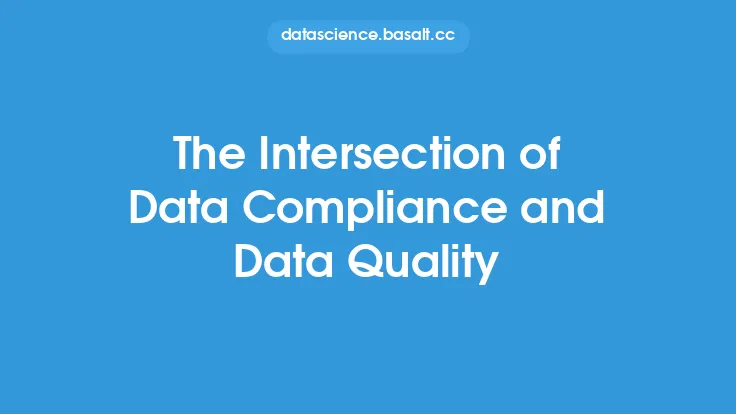Data reduction is a crucial step in the data mining process, as it enables organizations to extract valuable insights from large datasets while minimizing the risk of information overload. By reducing the volume of data, organizations can improve the quality and accuracy of their data, making it more reliable for analysis and decision-making. In this article, we will delve into the impact of data reduction on data quality and accuracy, exploring the various ways in which data reduction can affect the integrity of data.
Introduction to Data Quality
Data quality refers to the degree to which data is accurate, complete, and consistent. High-quality data is essential for making informed decisions, as it provides a reliable foundation for analysis and modeling. Data quality issues can arise from various sources, including data entry errors, inconsistencies in data formatting, and missing values. Data reduction can help mitigate these issues by identifying and eliminating redundant, irrelevant, or erroneous data, thereby improving the overall quality of the data.
The Effects of Data Reduction on Data Accuracy
Data accuracy is a critical aspect of data quality, as it refers to the degree to which data reflects the true values of the variables being measured. Data reduction can impact data accuracy in several ways. On the one hand, data reduction can help eliminate noisy or erroneous data, which can improve the accuracy of the remaining data. On the other hand, data reduction can also lead to the loss of important information, particularly if the reduction method is not carefully chosen. For example, if a dataset contains a large number of features, some of which are highly correlated, a data reduction method that eliminates features based on correlation may inadvertently remove important information.
Types of Data Reduction and Their Impact on Data Quality
There are several types of data reduction, each with its own strengths and weaknesses. Dimensionality reduction, for example, involves reducing the number of features or variables in a dataset, while keeping the most important information. This can be achieved through techniques such as principal component analysis (PCA), singular value decomposition (SVD), or feature selection. Data aggregation, on the other hand, involves combining multiple data points into a single value, such as calculating the mean or median of a set of values. Data aggregation can help reduce the volume of data, but it can also lead to the loss of important information, particularly if the data is heterogeneous.
Data Reduction Techniques and Their Effects on Data Quality
Various data reduction techniques can be used to improve data quality, including data cleaning, data transformation, and data normalization. Data cleaning involves identifying and correcting errors in the data, such as handling missing values or removing duplicates. Data transformation involves converting data from one format to another, such as converting categorical variables into numerical variables. Data normalization involves scaling data to a common range, such as between 0 and 1, to prevent features with large ranges from dominating the analysis. These techniques can help improve data quality by reducing the impact of noise and errors, but they can also introduce new issues, such as information loss or bias.
The Role of Data Reduction in Handling Missing Values
Missing values are a common problem in datasets, particularly in cases where data is collected from multiple sources or over a long period. Data reduction can help handle missing values by identifying patterns in the data that can be used to impute missing values. For example, if a dataset contains a feature with a large number of missing values, a data reduction method such as mean or median imputation can be used to fill in the missing values. However, data reduction can also exacerbate the problem of missing values, particularly if the reduction method is not carefully chosen. For example, if a dataset contains a large number of features with missing values, a data reduction method that eliminates features based on the number of missing values may inadvertently remove important information.
The Impact of Data Reduction on Data Mining Algorithms
Data reduction can have a significant impact on the performance of data mining algorithms, particularly those that are sensitive to the quality and quantity of data. For example, decision trees and random forests are sensitive to the number of features in the dataset, and data reduction can help improve their performance by reducing the risk of overfitting. On the other hand, data reduction can also affect the performance of algorithms such as clustering and dimensionality reduction, which rely on the relationships between features to identify patterns in the data. Therefore, it is essential to carefully evaluate the impact of data reduction on the performance of data mining algorithms to ensure that the reduced data is still suitable for analysis.
Best Practices for Data Reduction
To ensure that data reduction improves data quality and accuracy, it is essential to follow best practices, such as carefully evaluating the impact of data reduction on the data, using techniques that preserve the relationships between features, and avoiding the loss of important information. Additionally, data reduction should be performed in conjunction with data cleaning and data transformation to ensure that the data is accurate, complete, and consistent. By following these best practices, organizations can ensure that data reduction improves the quality and accuracy of their data, making it more reliable for analysis and decision-making.
Conclusion
Data reduction is a critical step in the data mining process, as it enables organizations to extract valuable insights from large datasets while minimizing the risk of information overload. By reducing the volume of data, organizations can improve the quality and accuracy of their data, making it more reliable for analysis and decision-making. However, data reduction can also have unintended consequences, such as the loss of important information or the introduction of bias. Therefore, it is essential to carefully evaluate the impact of data reduction on data quality and accuracy, using techniques that preserve the relationships between features and avoiding the loss of important information. By following best practices for data reduction, organizations can ensure that their data is accurate, complete, and consistent, making it more reliable for analysis and decision-making.





